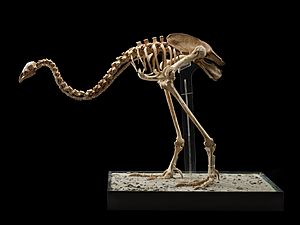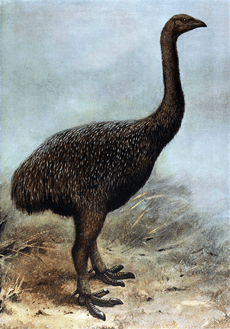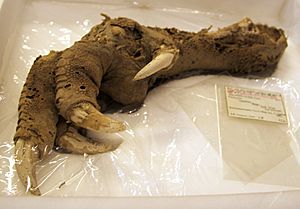Upland moa facts for kids
The upland moa (Megalapteryx didinus) was a special type of moa that only lived in New Zealand. It was a member of the ratite family, a type of bird that couldn't fly, like an ostrich or emu. They didn't have a strong chest bone (called a keel) that flying birds use for their wing muscles. The upland moa was the last type of moa to disappear, around the year 1500. It mostly lived in cold, high-up mountain areas.
Quick facts for kids Upland moaTemporal range: Pleistocene-Holocene
|
|
|---|---|
 |
|
| Mounted skeleton | |
| Conservation status | |
|
Extinct (ca. 1500)
|
|
| Scientific classification | |
| Genus: |
Megalapteryx
|
| Species: |
didinus
|
| Synonyms | |
|
list
Palaeocasuarius Forbes 1892 ex Rothschild 1907
Dinornis didinus Owen 1882 ex Owen 1883 Anomalopteryx didina (Owen 1883) Lydekker 1891 Megalapteryx hectori Haast 1884 ex Haast 1886 Megalapteryx tenuipes Lydekker, 1891 Megalapteryx hamiltoni Rothschild 1907 Palaeocasuarius velox Forbes 1892 ex Rothschild 1907 Palaeocasuarius elegans Rothschild 1907 Palaeocasuarius haasti Forbes 1892 ex Rothschild 1907 Megalapteryx benhami Archey 1941 |
|
Contents
What is the Upland Moa?
The upland moa was one of the smallest moa species. It stood less than 1 meter (about 3 feet) tall. It weighed around 17 to 34 kilograms (37 to 75 pounds).
How did the Upland Moa look?
Unlike other moas, the upland moa had feathers covering almost its entire body. Only its beak and the bottoms of its feet were bare. This was a special feature that helped it stay warm in its cold home.
Scientists used to think the upland moa held its neck and head straight up. However, we now know it actually walked with its head low, level with its back. This stooped way of walking helped it move through thick plants. A long, stretched-out neck would have been better for open areas. The upland moa had no wings or tail.
Where did the Upland Moa live?
The upland moa lived only on New Zealand's South Island. It preferred mountains and areas just below the mountains. These birds could travel to very high places, up to 2,000 meters (about 7,000 feet) above sea level.
What did the Upland Moa eat?
The upland moa was a herbivore, meaning it only ate plants. Scientists figured this out by studying what was found in their fossilized stomachs and droppings. They also looked at the shape of its beak and crop (a part of a bird's throat that stores food).
It ate leaves and small twigs. It used its beak to cut plants like scissors. Its food needed to be ground up before it could be digested. This is why it had a large crop. Studies show its diet included small branches from trees like Nothofagus, different herbs from lake edges, and tussock grass.
Upland Moa reproduction and family life
This moa usually laid only one or two eggs at a time. Its eggs were a unique blue-green color. It was likely the only type of moa to lay eggs that were not white. Like emus and ostriches, the male moa probably took care of the young birds.
Who hunted the Upland Moa?
Before humans arrived in New Zealand, the only animal that hunted the upland moa was the Haast's eagle.
Why did the Upland Moa disappear?
Humans first met the upland moa around 1250 to 1300 AD. This was when the Māori people came to New Zealand from Polynesia. Moa were calm animals and an easy source of food for the Māori. Sadly, they were hunted until they became extinct around the year 1500.
Important Discoveries
Scientists have found several upland moa specimens with soft body parts and feathers still attached. These discoveries help us learn a lot about them:
- A specimen found in Queenstown in 1876 is the main example for the species. It is kept at the British Museum.
- A leg with a lot of muscle, skin, and feathers was found in the Old Man Range. It is now at the Otago Museum.
- A skeleton with tissue on its neck and head was found near Cromwell. It is at the Museum of New Zealand Te Papa Tongarewa.
- A foot with some muscle and tendons was found on January 7, 1987, at Mount Owen. This foot was about 3,300 to 3,400 years old. It is also at the Museum of New Zealand Te Papa Tongarewa.
- Feathers found in 1949 in Takahe Valley, Fiordland, New Zealand, are at the Museum of New Zealand Te Papa Tongarewa.
- Parts of an egg were found at the Rakaia River in 1971. Scientists think it might belong to this species. The eggshell is dark olive green, which is unusual. This egg is at the Canterbury Museum.
- A complete skeleton was found by Trevor Worthy in March 1987 at Honeycomb Hill Cave. It is at the Museum of New Zealand Te Papa Tongarewa.
- A skeleton and part of an egg were found in 2002 at Serpentine Range, Humboldt Mountains. These are at the Otago Museum.




